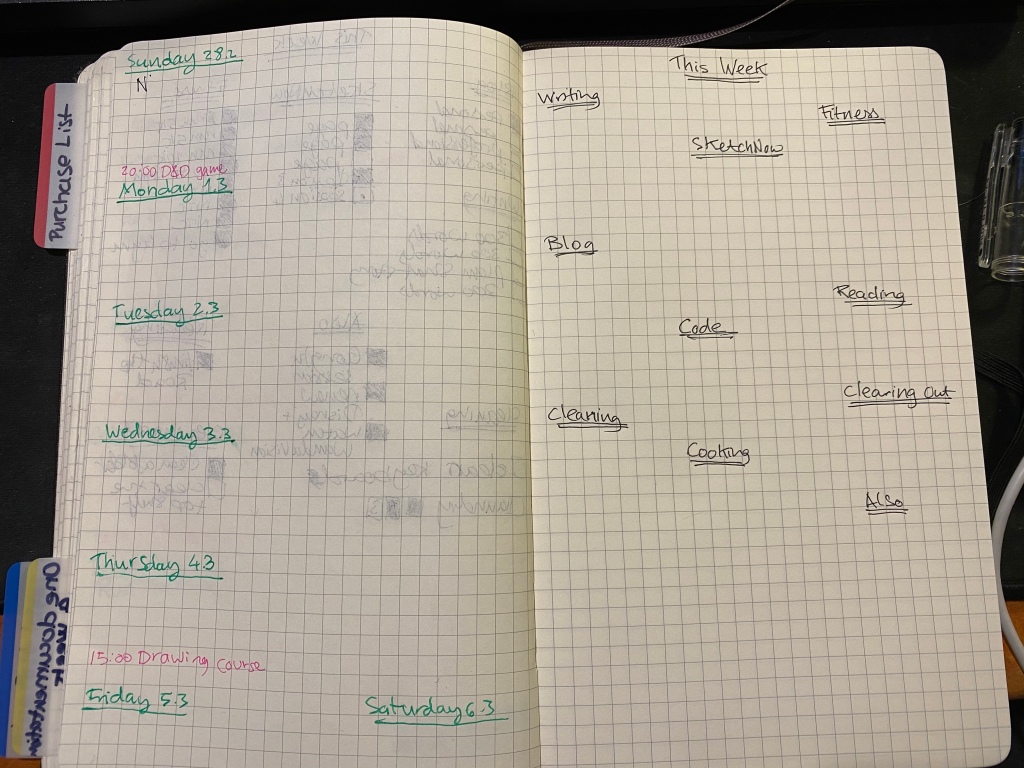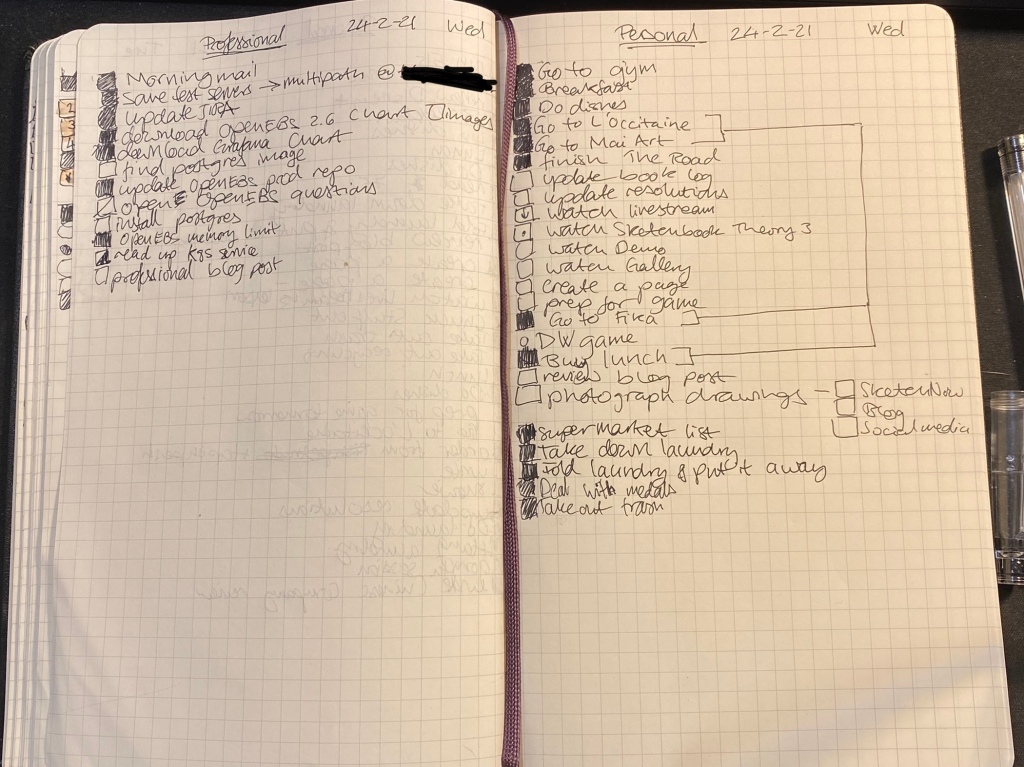Cat Comfort

Another spread from my sketchbook, also created as part of the Sketchbook Design course. I still need to find a way of drawing my black cat without him turning into a dark blob on the page.
A blog about writing, sketching, running and other things

Another spread from my sketchbook, also created as part of the Sketchbook Design course. I still need to find a way of drawing my black cat without him turning into a dark blob on the page.

When Covid-19 hit last year and I started working from home my old task management system completely disintegrated. It was a combination of trying to find a new work/life/health balance, coupled with starting a new job that really made me aware that my old running daily work checklist and home checklist were no longer going to work. I was also keenly aware that I could no longer do any long term planning, and yet that I had to find a way to plan ahead somehow, or I’d accomplish none of my long term goals. After trying several systems with little to no success, it took until January 2021 for me to find a system that worked for me. In the hopes that this may help someone build out their own system, here is a glimpse into mine.
The system is built into two separate Moleskine Large Hardcover Squared notebooks. This was my notebook of choice for my previous system, and it has served me well. I don’t use fountain pens for my planning, just fine gel pens, and I don’t mind the ghosting, as I find that it’s more pronounced in photos than it is when I actually use the page. One notebook is my weekly planner, and I reference it about once or twice a day. The other notebook is my daily task list, and I reference and update it all the time. Why two notebooks and not one notebook with both a weekly plan and daily pages? I tried that and the need to constantly flip between pages with no ability to see my weekly plan before me as I create my daily task lists was too much for me to deal with. I don’t have a dearth of notebooks and I do have dearth of time and attention, so two notebooks it is.
Here’s a weekly notebook spread:

Each spread in my weekly notebook is divided between my weekly schedule/plan on the the left hand side of the spread, and a weekly goal list on the right hand side. This is a sample of the following week’s spread before I start really filling it. On the left hand side I fill in the days of the week and the dates. I put in appointments and things that I need to take into account while doing my planning, but this page isn’t a replacement for my Fantastical calendar. I still want and heavily use a digital calendar with reminders, but this notebook page is crucial for my ability to see and plan ahead. I plan and think better on paper, and so if I have a D&D game on a certain day, I know that I need to schedule time to prep for it. This is also where I plan my weekly training: when I run, when I go to the gym and when I rest. I also use it to plan ahead things that I need to be aware of for my mother’s various doctor’s appointments, from reminders, to various forms that need to be filled, blood tests scheduled etc.
The right side of the page is the most important part of each spread, as it is where I plan out what I want to get done each week. My yearly goals are broken down and mapped out week by week here. I break the goals down by title, and then write down 2-3 related goals under each one (except the fitness goal which gets more). Some goal groups are consistent – fitness, reading, writing, blog, cleaning. Other goal groups change depending on the week and my focus. The “Also” goal group is for miscellany, such as watching a weekly episode of a show that I don’t want spoiled, or renewing/cancelling subscriptions.
The daily notebook is much simpler, and is merely an evolution of my old task system, adapted to working from home:

On the left side of every work day there is a professional task list, with work related things that I want to do that day. On the right side of the page is the personal task list, with stuff that I want to do before and after work. On weekends the two sides of the page simply both list out personal tasks. This system is clear, simple to use, flexible and doesn’t require a lot of “meta” effort to set up or maintain.
If you’re struggling with time management lately, take some time to create a system that works for you and doesn’t overwhelm you. I highly recommend not using a planner but rather creating your own schedule, since it saves you from the disappointment and stress of empty planner pages. It also allows you to add specific pages to your setup as the need arises. For instance, as global shipping and our local post office have gone haywire since Covid, I dedicated a spread in my weekly notebook to tracking various shipments. When I need to go to the post office to collect a package I note it down in my schedule, and so it was easy for me to use a different page on the same notebook to track the status of each package.
Let me know if this was helpful, and if you’ve also been forced to revamp your planning over the past year.

This is the first time I’ve used colour blocks to design a page in this way, with vertical drawings and horizontal text. This page was created as a contained composition for Liz Steel’s Sketchbook Design course (highly recommended, especially if you have a basic handle on drawing and sketching already). I normally would have just done an overlapped jumble of all the things that we cooked that evening, to convey a bit of the chaos of cooking so much in just an hour and a half, but I forced myself to think of a way of creating some of that night’s feeling using a contained composition. The vibrant turquoise was what brought this page to life for me: a joyful colour that connects me with what I learned about Mexico during that evening, and the happiness of cooking my way through a small part of the wonderful Mexican cuisine.
BTW – I just noticed that Jenny Mason from The Finer Point also took the Sketchbook Design course. I love the vibrant spreads that she’s created. Go check them out.

I’m still working to clear my backlog, as life is starting to get back to normal. This spread was part of the Sketchbook Design course assignment focusing on contained compositions. I find drawing night scenes in watercolour particularly difficult and so I tend to avoid them. However, I couldn’t pass on the chance to draw the night heron I saw at night, and so this spread emerged.

I’ve had a rough two weeks, with my mom going through surgery to remove tumours during a Covid lockdown and other stuff crumbling at the same time. Starting to get back to my my routine again, which means posting here, working on a review and working on another short story.
This page shows a deserted Dizengoff street, which I haven’t seen since the first lockdown, last spring.
Hoping for better days ahead.

Tel Aviv Municipality has come up with a great way to support local businesses during the lockdown. Once a day at 11:00 they open the option for around 30-40 people to purchase a box from a local business. The box costs 50 NIS, and comes with a zoom session with the store owner, where you learn about their business and make something together. There was a beer box, a sushi box, a stationery box, a magic shop box, a cocktail box, a pickles box, and more. The boxes proved to be more popular than city hall envisioned, so after a few days they limited it to one box per resident. Luckily I managed to get three boxes before the limit took place, and this was the first one. We learned how to make two plant holders out of reclaimed pallet wood from a lovely design studio in Jaffa called Molet. They create kits and give workshops using wood pallets and the results are charming and fun. My dad had a workshop with them before the pandemic and really enjoyed it, and I’ll try and get the people at work to go to a workshop there once we can.
This sketchbook page was created as part of Liz Steel‘s Sketchbook Design course and explores using collage and colour blocks as design elements.

I don’t often get to see grey herons during my runs, so I decided to make a hero of this sketchbook page. Drew a map for the first time in my sketchbook and it was hard and took longer than I expected.Drawing the ramen bowl was also challenging, but I really like the results. I like this spread even though at the beginning I thought that I’d have to trash it, because some terrible masking tape that I used tore into the right page quite badly. Glad that I stuck with it.
This page was created as part of Liz Steel‘s Sketchbook Design course and explores using maps in your sketchbook.

I tried to get my hands on the Timex X DDC Scout watch designed by Aaron Draplin for three times before I managed to snag one. They are sold out so quickly that if you want one you really need to set an alarm and be quick with your keyboard and mouse. Then our local post office tried to do a vanishing act with my package, but finally, a month after I ordered it, I got my hands on this orange and black beauty. I only use analogue watches, usually Swatch watches (in recent years it was System 51 Swatch mechanical watches), but I’ve never owned such a heavy watch. It took me a day to get used to it, and since then it has been my constant companion. It is a beast of a MACHINE but an eye catching one, and I couldn’t be happier with my purchase. I highly recommend getting one, if you have any interest in watches.
This page was created as part of Liz Steel‘s Sketchbook Design course and is all about the white space.